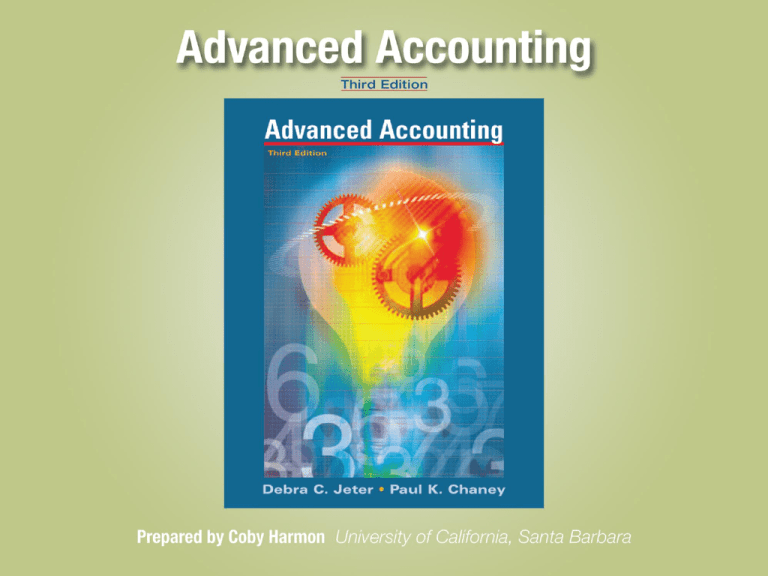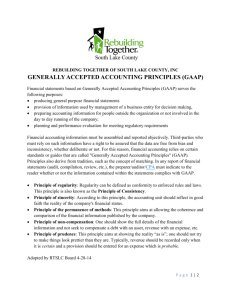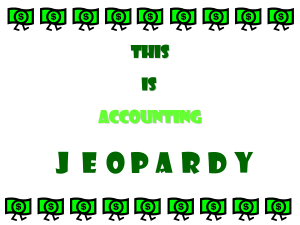
Chapter
11-1
11
International Accounting and the
Global Economy
Advanced Accounting, Third Edition
Chapter
11-2
Learning Objectives
1.
Describe how the changing world environment is leading
to an increased focus on international accounting
standards.
2.
Explain some differences in accounting methods as they
are applied internationally.
3.
List five major classifications of accounting models used
in different geographical regions.
4.
Describe the role of the International Accounting
Standards Committee and the International Accounting
Standards Board in establishing international accounting
standards.
Chapter
11-3
Learning Objectives
5.
List the steps that a non-U.S. company must follow to
list its shares on a U.S. stock market.
6.
Explain the role of form 20-F filed with the Securities
and Exchange Commission.
7.
Indicate the role of American Depository Receipts in the
issuing of securities of non-U.S. companies in the United
States.
Chapter
11-4
The Increasing Importance of International
Accounting Standards
Beginning in 2005, the European Union (EU) mandated
that accounting standards for companies listed in its
securities markets conform to International Financial
Reporting Standards.
In 2006, the total value of cross-border transactions in
bonds and equities was $90 trillion U.S. dollars annually.
Chapter
11-5
LO 1 Increased focus on International Accounting Standards.
Importance of International Accounting Standards
FIGURE 11-1
Composition of the Global Equity and Debt Markets
by Each Country’s Domestic Securities
Chapter
11-6
LO 1 Increased focus on International Accounting Standards.
Importance of International Accounting Standards
FIGURE 11-1
Composition of the Global Equity and Debt Markets
by Each Country’s Domestic Securities
Chapter
11-7
LO 1 Increased focus on International Accounting Standards.
Importance of International Accounting Standards
FIGURE 11-2
Holdings of U.S. and Foreign Securities, 1994–2004
Market Value of Holdings of U.S. and
Foreign Securities, 1994-2004
Foreign holdings
of U.S. securities
(1.2 to 6 trillion
increase)
U.S. holdings of
foreign securities
(870 billion to 3.5
trillion increase)
Chapter
11-8
LO 1 Increased focus on International Accounting Standards.
Importance of International Accounting Standards
The demand for uniform international accounting
standards has increased because:
Investors seek comparable standards to evaluate
investment opportunities,
Managers seek to evaluate the performance of
foreign subsidiaries and competitors, and
Creditors and debt capital markets seek comparable
standards to determine credit quality and
bankruptcy risk.
Chapter
11-9
LO 1 Increased focus on International Accounting Standards.
Harmonization of Worldwide Accounting Standards
Financial accounting practices, required disclosures, and
auditing requirements are not uniform across countries.
Variations exist in the accounting for:
Goodwill.
Business combination methods.
Tax allocation.
LIFO inventory costing.
Development costs.
Use of reserves
Chapter
11-10
LO 1 Increased focus on International Accounting Standards.
Harmonization of Worldwide Accounting Standards
The International Accounting Standards Committee
(IASC) was founded in 1973.
41 standards were issued by January 2001.
In 2001, the IASC announced formation of the
International Accounting Standards Board (IASB).
Goal is to develop high-quality internationally
accepted accounting standards.
Issues standards known as International
Financial Reporting Standards (IFRS).
To date six IFRSs have been issued.
Chapter
11-11
LO 1 Increased focus on International Accounting Standards.
Harmonization of Worldwide Accounting Standards
Harmonization of accounting standards. The International
Accounting Standards Committee (IASC) was founded in
1973.
In 2002, the FASB and IASB agreed to begin
converging U.S. GAAP and the IFRSs.
By 2005, over 90 countries had announced they
would be following IFRSs.
In 2005, European Union requires publicly traded EU
companies to follow IFRSs.
Chapter
11-12
LO 1 Increased focus on International Accounting Standards.
Comparative Accounting Models
Differing accounting practices could result in the same
economic event being reported differently.
FIGURE 11-3
Differences in Net Income and Equity due to Differing GAAP
= ROE
Chapter
11-13
LO 2 Differences in accounting methods.
Comparative Accounting Models
Format and Terminology Differences
Some non-U.S. companies prepare statements in:
English still using their national GAAP.
Their local currency with a column that is translated
into U.S. dollars.
English conforming to U.S. GAAP or the IFRS.
The first step is to determine which GAAP is being used.
Chapter
11-14
LO 2 Differences in accounting methods.
Comparative Accounting Models
Format and Terminology Differences
Examples of terminology differences:
Chapter
11-15
LO 2 Differences in accounting methods.
Comparative Accounting Models
Format and Terminology Differences
Various formats are allowed in presenting financial
statements in different countries.
In the UK:
Noncurrent assets are listed first in the balance
sheets.
Current assets listed second and in order of increasing
liquidity (i.e., the most liquid assets are listed last).
Assets and liabilities are combined to compute total
net assets.
Chapter
11-16
LO 2 Differences in accounting methods.
Comparative Accounting Models
Review:
A company located in Japan prepares an annual
report denominated in U.S. dollars. Any report
denominated in U.S. dollars is always prepared
in accordance with U.S. GAAP.
False
Chapter
11-17
LO 2 Differences in accounting methods.
Comparative Accounting Models
Review:
In the United Kingdom, stock refers to
common stock.
False,
stock refers to inventory
Chapter
11-18
LO 2 Differences in accounting methods.
Comparative Accounting Models
Review:
Since 2005, all European Union companies
listed on a regulated market are required to
prepare consolidated accounts in accordance
IASB accounting standards.
True
Chapter
11-19
LO 2 Differences in accounting methods.
Classification of International Accounting Models
Five Major Geographical Classifications:
Type of Accounting Practice
Region
Anglo-Saxon
United States
Anglo-Saxon
United Kingdom
German
Germany, Switzerland
Latin
France, Italy, Brazil
Asia-Pacific
Japan, China
Chapter
11-20
LO 5 Five major classifications of accounting methods.
Classification of International Accounting Models
Accounting Standards in the United Kingdom
Standards referred to as Financial Reporting
Standards (FRS).
Issued by the Accounting Standards Board (ASB).
The ASB strongly supports the IASB.
ASB is considering a full conversion to IFRS
implementation that would require companies to
comply completely by January 1, 2009.
Chapter
11-21
LO 5 Five major classifications of accounting methods.
Classification of International Accounting Models
Accounting Standards in Germany
Historically, standard setting has been the
responsibility of the Federal Ministry of Justice (FMJ).
In 1998, FMJ recognized a new independent body, the
German Accounting Standards Board (GASB).
As of 2005, preparation of financial statements
according to IAS became mandatory for public
companies.
GASB is now relevant primarily for unlisted companies.
Chapter
11-22
LO 5 Five major classifications of accounting methods.
Classification of International Accounting Models
Accounting Standards in Japan
In February 2001, the
Financial Accounting Standards Foundation (FASF)
and
Accounting Standards Board (ASB),
were formed to develop accounting standards.
Accounting Standards Board has been working with the
IASB in a path toward standards convergence. It plans
to reconcile these differences to IAS by 2008.
Chapter
11-23
LO 5 Five major classifications of accounting methods.
International Reporting Issues
Treatment of Goodwill
Since June 30, 2001, goodwill is only expensed if
impaired under U.S. GAAP.
Amortization of goodwill is required under the Japanese
model, with a life of five years.
Under IAS standard 38, internally generated goodwill is
not capitalized.
Chapter
11-24
International Reporting Issues
Inventories
LIFO is not acceptable under IAS.
IASB recommends specific cost. If specific cost is not
determinable, the benchmark is FIFO or weighted
average.
Chapter
11-25
International Reporting Issues
Research and Development
In the United States:
Research and development (R&D) costs are expensed
as incurred.
In acquisitions, in-process R&D is recognized as an
expense.
IAS No. 38:
Research costs are expensed as incurred.
Development costs are capitalized when a product is
determined to be commercially feasible.
Purchased R&D costs are capitalized and amortized.
Chapter
11-26
International Reporting Issues
Business Combinations
Purchase method required under U.S. GAAP.
Purchase method required under International
Accounting Standards (IAS).
Pooling is not permitted in Japan and is used
infrequently in other countries.
Chapter
11-27
International Reporting Issues
Fixed Assets and Depreciation
In several countries, fixed assets are valued at
depreciated historical cost (Japan and the United
States).
Under IAS 16, fixed assets are initially valued at cost.
Subsequently, they can be valued under either the:
Cost model, or the
Revaluation model.
Chapter
11-28
International Reporting Issues
SEC Registration and
U.S. Listing for Non-U.S. Companies
Registration with the SEC under the 1934 Securities
Act is mandatory for non-U.S. companies that intend to
list on a U.S. stock market.
Foreign companies are required to comply with the SEC
continuous reporting requirements.
U.S. companies file forms 10-K and 10-Q.
Foreign companies file forms 20-F and 6-K.
Chapter
11-29
LO 5 U.S. listing for non-U.S. companies.
International Reporting Issues
20-F Statement
The 20-F filing is similar to the 10-K filing.
The 20-F allows the non-U.S. company to retain its local
GAAP reporting, so long as it meets one of two
alternative conditions. The firm may either
1. reconcile net income and the shareholders’ equity,
thus showing earnings based on U.S. GAAP; or
2. fully disclose all financial information required of
U.S. firms.
Chapter
11-30
LO 6 The role of form 20-F.
International Reporting Issues
Statement F-1
First-time offer of securities by any non-U.S. company
requires filing an F-1 statement as the principal
registration statement.
Prospectus contains:
Financial statements (reconciled to U.S. GAAP).
Nonfinancial information about the company.
Chapter
11-31
International Reporting Issues
Reconciliation to U.S. Accounting Principles
The footnote reconciling GAAP between the U.S. and
another country can be very informative in terms of
highlighting differences in accounting between countries.
Chapter
11-32
American Depository Receipts (ADRs)
A Depository Receipt (DR) is a derivative instrument that
usually represents a certain fixed number of publicly
traded shares of a non-U.S. corporation.
American Depository Receipt (ADR) – traded in the
United States.
Global Depository Receipt (GDR) - traded outside the
United States.
ADRs may trade freely like any U.S. security on one of the
major exchanges.
Chapter
11-33
American Depository Receipts (ADRs)
Types of ADR Programs
Level I:
Depository banks create an ADR program based on the
underlying shares that already trade on home markets.
No capital raised.
ADRs are not listed on U.S. markets.
Trading confined to “pink sheet” market.
Chapter
11-34
American Depository Receipts (ADRs)
Types of ADR Programs
Level II:
Do not involve raising new capital.
Issues are registered with the U.S. SEC and listed on a
major U.S. stock exchange.
Companies must file F-6 and 20-F.
Chapter
11-35
American Depository Receipts (ADRs)
Types of ADR Programs
Rule 144A:
Rule 144A ADRs are those ADRs placed privately among
large institutional buyers (known as QIB firms) with
restrictions on subsequent trading of these securities.
Rule 144A ADRs are not publicly traded or listed on U.S.
stock exchanges and can be exchanged only among QIBs.
Chapter
11-36
International Reporting Issues
Review Question
In preparing a 20-F filing, a non-U.S. company can retain its
local GAAP reporting as long as it meets certain conditions.
Which of the following alternatives satisfies these conditions?
a. The firm must reconcile net income and shareholders’
equity from the non-U.S. GAAP to U.S. GAAP.
b. The firm must fully disclose all financial information
required of U.S. firms, including segmental disclosures.
c. The firm is allowed to retain local GAAP reporting if it
meets either (a) or (b) above.
d. The firm is allowed to retain local GAAP reporting only if
it meets both (a) and (b) above.
Chapter
11-37
Copyright
Copyright © 2008 John Wiley & Sons, Inc. All rights reserved.
Reproduction or translation of this work beyond that permitted
in Section 117 of the 1976 United States Copyright Act without
the express written permission of the copyright owner is
unlawful. Request for further information should be addressed
to the Permissions Department, John Wiley & Sons, Inc. The
purchaser may make back-up copies for his/her own use only
and not for distribution or resale. The Publisher assumes no
responsibility for errors, omissions, or damages, caused by the
use of these programs or from the use of the information
contained herein.
Chapter
11-38





